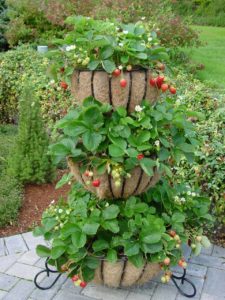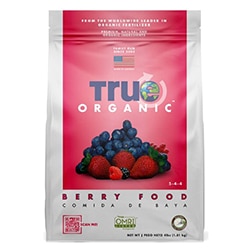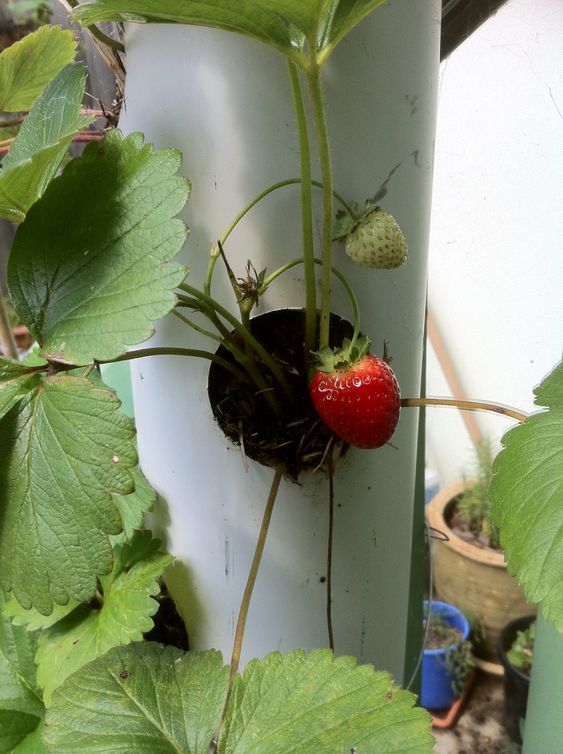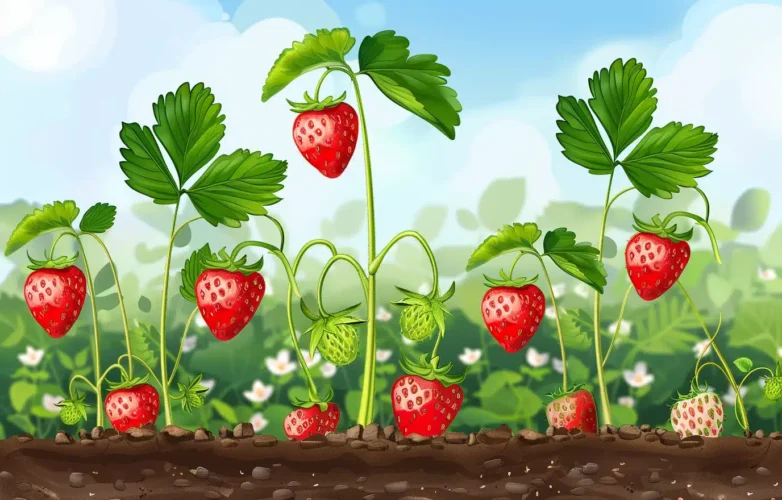
Strawberries are some of the most popular fruit grown by gardeners because they can be grown almost anywhere in almost any container. Strawberry plants can be grown in traditional containers, such as flower pots & and window planters, or unique containers like PVC pipes, rain gutters, grow bags, and even shipping pallets. In this guide, we'll walk you through the process of growing strawberries in pots by helping you identify the right strawberry variety, container, and care strategy for your plants. For a more detailed guide on growing strawberry plants in general, check out our master guide on How to Grow Strawberries.
Snapshot: Growing Strawberries in Pots
Best Strawberry Types for Containers:
Everbearing, Alpine, Day Neutral.
Container Size:
Strawberries should be planted in containers with a minimum diameter of 4-6"inches and at least 6-8" of depth.
Plant Spacing:
Strawberries can be planted up to 4 plants per square foot in containers. If space is not an issue, allow 10-12" inches between each plant.
How to Plant:
Transplant strawberry plugs and bareroot plants into a hole deep enough to accomodate the whole root system (avoid creating bent "J" shaped roots). Backfill firmly with soil up to just below the plant's crown.
Sunlight:
Strawberries love the sun! Place containers in a location where strawberries will receive 8 hours+ of full sunlight daily.
Watering:
Water shallowly & frequently. Strawberry plants need 1" inch of water per week. Strawberries in containers may require more water depending on the size of the pot. Check soil frequently.
Best Soil:
Nutrient rich, well-draining, slightly acidic potting soil (pH 5.5-6.5) amended with compost, aged manure, or berry food fertilizer.
Fertilizer:
Side dress with compost, aged manure, berry food, or blood meal in early spring and after the last harvest.
Harvesting:
Plants reach maturity approximately 30 days after blooming. Harvest berries when they turn deep red.
Strawberry Planting Basics: Know Before You Grow

Before we get started, let's take a moment to learn about strawberries and how they grow. Strawberries can be grown in containers as perennials in almost any zone provided that the containers can be adequately shielded from extreme heat and frost. Strawberry plants are categorized into three varieties based on their fruiting behavior: Junebearing and Everbearing/Day Neutral. For the purposes of growing strawberries in containers, it's best to stick with everbearing and day neutral types.
Junebearing Strawberries:
Junebearing strawberry plants produce a single large crop of strawberries around mid-summer (June/July); hence, the name "June" bearer. Junebearers offer the largest yield, biggest berries, and most runners of any other variety. Because these plants produce a lot of runners, they are typically avoided for container growers who do not wish to propagate plants. On the other hand, Junebearers may be great for those with large raised garden beds with room for spreading.
Everbearing Strawberries:
Everbearing strawberry varieties produce two crops each year: one in early summer and another in early fall. Everbearers allow you to enjoy fresh strawberries throughout the growing season--although each crop is relatively small compared to the single crop Junebearers. Everbearers are ideal for small containers because they produce few runners and, thus, require minimal maintenance.
Day Neutral Strawberries:
As long as temperatures remain between 35-85°F, Day Neutral strawberries will continue to produce fruit throughout the growing season. Day Neutrals produce smaller fruit, less runners, and offer more opportunities for continuous harvests (albeit smaller harvests) than Junebearing varieties. Another great choice for container gardeners.
Woodland Alpine Strawberries:
Alpine strawberries are technically a kind of Day Neutral berry, but are often sold as ground cover and edible perennial landscaping. Wild strawberries are great for small containers and window boxes. These varieties produce small harvests of tiny berries throughout the growing season and are more adaptable to shady locations. Unlike strawberry plugs and bareroots, alpine strawberries are often direct-sown and germinated from seed.
How to Choose the Right Strawberry Pot

There are many guides (including this one) that will claim that strawberries need pots of a certain size and depth in order to survive. The dirty little truth of strawberry gardening is this: with the right care, strawberry plants can thrive in almost any container! You're really only limited by your imagination. I've grown strawberry plants successfully in tiny 4" terracotta pots on a windowsill and in a large in-ground beds with 1,500 plants.
The trick is to figure out what "the right care" means for your strawberry plants. At the end of the day, what strawberries really need to thrive is good sunlight and damp (not wet) nutrient-rich acidic soil. Regardless of your pot size, it is up to you, the grower, to ensure that the needs of your strawberry plants are met. For example, small strawberry pots may be aesthetically pleasing, but they will require you to water and fertilize your strawberry plants more frequently. Large pots allow for better plant spacing, soil health, and moisture retention, but they can also have issues with drainage and soil-borne disease. Here are a few things to consider when choosing a pot for your strawberry plants:
Container Size:
Up to a point, there is a correlation between plant size and container size. Strawberry plants grown in small pots will have smaller root systems than those grown in larger pots. Now, that doesn't mean strawberries grown in mega pots will grow into mega plants. If space were not an issue, gardeners give strawberries about 10-18" inches of space between plants and about 8-12"inches of soil depth. With that in mind, look for a container that's no smaller than 4" inches in diameter and 6" inches deep.
Drainage:
Strawberries have relatively shallow roots which aren't the best at growing through hard, rocky, clay-like soil. Even the best potting soil can become a clumpy wet mess without adequate drainage. Look for a pot with drainage holes, one made out of a porous material (such as terracotta), or a container that you can add drainage holes to. Consider adding a mesh cover (wire mesh or cheesecloth) over the drainage holes to prevent soil loss from frequent watering.
Container Material:
There are a few things to consider about the type of pot you select for your strawberry plants. First, some planters and pots are more porous than others. Terracotta pots, for example, are porous and result in faster moisture loss than plastic or ceramic pots. Secondly, different colors and materials retain heat better than others. For example, black plastic pots and stainless steel planters heat up quickly in direct sunlight. On the other hand, ceramic, stone, and terracotta pots remain cooler longer. Choose a material and color for your strawberry pots that works best for your growing conditions.
Overwintering:
A well cared for strawberry plant will continue to produce good harvests for up to four years. However, they will need protection from extreme heat and frost. For mild climates, this could mean adding a heavy layer of mulch onto the plants during the winter months. For more extreme climates, strawberry plants must either be grown as annuals or need to be brought indoors for protection. Consider this overwintering process when selecting a container as heavier containers may be too difficult to move.
Popular Strawberry Planters
Hanging Strawberry Pot:
Hanging strawberry planters are a popular choice for porch, balcony, and vertical gardeners. As strawberries mature, the ripe berries hang down from the mother plant for easy harvesting. Strawberries can be grown in almost any hanging planter with adequate drainage. Be sure to hang your strawberries in a sunny location that you can easily reach for routine maintenance.
Strawberry Window Box:
A sunny window box is the ideal indoor or outdoor container location for strawberries. Growing strawberries on a windowsill is simple; just find a long, narrow planter that fits snugly on a windowsill and plant your berries as normal. It is also a good idea to add a layer of mulch in window box beds to prevent rapid moisture loss. Window boxes behind glass windows may need to be watered as often as daily during sunny periods.
Strawberry Flower Pots:
Strawberry plants can be grown individually in small flower pots with a little extra effort. Small pots require high-quality soil, frequent fertilizing, and good water management. Start with an organic potting soil blend, keep a berry food fertilizer on hand, and consider installing an automatic waterer in each flower pot to ensure that your strawberry plants never dry out.
Vertical Strawberry Planters:
In addition to hanging strawberry planters, strawberries can be grown vertically in other ways as well. Some of the most creative vertical strawberry planters I've ever seen were made of recycled materials such as pallets, crates, PVC pipes, and concrete blocks.
Raised Garden Beds:
A raised garden bed is a fantastic location for a perennial strawberry patch. Large raised beds allow for bigger strawberry root systems, bigger plants, and bigger patch sizes. Junebearers can be planted in large raised bed patches and allowed to propagate in the additional space. If you have the space, consider planting your strawberries in a raised garden bed.
- Sun Gro: Black Gold Organic Potting Soil Mix: A nutrient-dense, well-draining potting mix packed with organic fertilizer that we use for our potted berries.
- Mr. Stacky 5-Tier Strawberry Planter Pot: The quintessential vertical strawberry planter pot for small spaces. Take sup just 12" of floor space and fits 20 strawberry plants.
- Automatic Watering Bulbs for Potted Plants: Potted strawberry plants need a lot of water. Watering bulbs are an easy way to provide consistent water to your plants when they need it.
Strawberry Plant Spacing for Pots
Strawberry spacing can be a confusing, and sometimes controversial, topic. The general rule of thumb for containers is to plant no more than 3-4 strawberry plants per square foot. The less plants we attempt to cram into a container, the healthier each individual plant will be. Too many plants in a container = smaller, less productive plants as they each fight for scarce nutrients. That's the tradeoff to keep in mind as you decide how many plants to include in a single pot.

Best Locations for Strawberry Pots
It cannot be stated enough: strawberry plants love full sunlight. In fact, it's even good practice to routinely rotate your strawberry pots to ensure that each side gets enough sunlight. Unless you are growing a variety of strawberry that can tolerate a shaded location, the best location for your strawberry pot is in an area that receives maximum sunlight. This includes sunny windowsills, decks and patios, balconies, sun rooms, greenhouses, and south-facing plots in the garden. . If your climate includes heavy frosts, then you'll want to mulch your potted strawberry plants and move them indoors for the winter.
Best Potting Soil & Amendments for Strawberries
One of the best things you can do for your strawberry plants is to start them off with high quality potting soil. Strawberries grown in their ideal soil conditions are less likely to succumb to disease, stress, and poor growth. First things first, purchase a high-quality, organic potting soil mix and consider amending it with an organic compost, berry food fertilizer, or coffee grounds for added acidity. I like to add an inch of pebble stone to the bottom of my containers before filling with potting soil for better drainage. Watch your strawberries and side-dress with compost or berry food before and after fruiting.
True Organic
Berry Food Fertilizer
Happy soil makes happy strawberry plants! Grow big, juicy, bright red strawberries with this organic strawberry fertilizer made with everything berries love.
Care & Maintenance of Strawberry Plants
Once established, strawberries plants grown in pots are actually easy to maintain. Again, strawberry care is simple: sunlight, water, and a little fertilizer boost once or twice during the growing season.
Strawberry Watering:
Strawberries need about 1" inch of water per week. This is a general guideline and depends greatly on your plant's specific location, container, soil type, etc. What we like to do is test the soil for dryness every few days or so with an index finger. Strawberries have shallow roots which penetrate about 6" below the soil. If the top 2-3 inches of soil feels dry when you dig in with your finger, give your plants a water. If it feels moist or wet, wait a few days and test again.
Strawberry Mulch:
Strawberries are named "straw" berries because gardener's discovered that these plants grow best when mulched in a deep bed of straw. All strawberry plants, whether planted in containers or in-ground beds, benefit from mulching. While you don't have to use straw as your mulch, it's strongly recommended that you mulch your strawberry patch. Mulching helps to retain moisture, prevent fungal diseases, delay fruit spoilage, and protect strawberries from frost during the winter months. To mulch, simply cover the top 2-5 inches of exposed top soil in your strawberry pot with a material like wood chips, pine needles, landscape fabric, pebbles & rocks, etc.
Strawberry Fertilizing:
Care should be taken not to overfertilize strawberry plants. When strawberry plants are overfertilized with nitrogen, the plant will prioritize leafy-green foliage growth over fruit production. If your strawberries were planted in nutritious soil to begin with, they may not need to be fertilized. Skip the fertilizer if your plants are growing well, appear strong, and have dark green vegetative growth. Otherwise, if your plants look like they need help, you can side-dress with compost, aged manure, or berry food shortly after the final harvest of the year in preparation for next season.
Better Reds
Red Mulching Film For Strawberries
Did you know that surrounding your strawberries with red mulch increases yields by up to 20%? The best kept secret for mega strawberries is red mulch!
Harvesting, Storing, & Preserving Strawberries

Harvesting strawberries is easy, right? You just pick 'em and eat 'em! Yes, but here are some expert tips from someone who has harvested thousands of berries:
- Ripe strawberries can be a bit soft; so, it's best to harvest them by breaking the attached stem instead of pulling on the berry itself.
- I know it's hard, but you must wait until the strawberries have ripened on the plant before harvesting because strawberries do not continue to ripen once they've been picked.
- When it comes to timing, you can plan to begin harvesting your strawberries about 30 days after they blossom.
If you've followed our guide and you're producing more strawberries than you can eat fresh, there are several methods for storing strawberries for short and long term use. This includes freezing, cooking, dehydrating, freeze drying, baking, fermenting, and many more. Here are just a few of our favorite ways to preserve our strawberry harvests:
Fresh Strawberries:
Strawberries are best enjoyed when picked and eaten fresh right away. If you cannot enjoy them right away, give them a quick vinegar rinse (1:3 ratio of vinegar to water), dry them thoroughly, and place them in a breathable container on a sheet of paper towel in the fridge. With this method, strawberries can be kept fresh for over a week.
Frozen Strawberries:
Freezing strawberries is incredibly simple and preserves your strawberry harvest for up to 12 months (although, we've personally stored frozen strawberries much longer than that). The best way to freeze strawberries is to place them on a baking tray on a single layer and freeze overnight. Once frozen individually, strawberries can be stored together in freezer bags without clumping up.
Dehydrated Strawberry Fruit Leather:
This is by far our favorite method of "preserving" strawberries. I say that in quotes because we eat the fruit leather so fast that it never ends up in storage. To make fruit leather, simply cook down your strawberries in a heavy-bottomed pot until soft, blend until smooth, cook on low until the puree has thickened, and then let cool to room temp. Pour a thin layer of the puree onto a baking sheet or dehydrator tray and dry on 145 degrees for 16 hours until no longer tacky.
Strawberry Container Growing & Maintenance Calendar
Here is a quick timeline of the entire process of starting, planting, and harvesting potted strawberries. This is an approximation based on a typical four-season climate. Please make necessary adjustments for very cold and very warm growing zones.
January - February
New Strawberries: Research strawberry varieties, prepare your garden bed, purchase your strawberry seeds, bare root plants, and starts.
Strawberry Seeds: Begin cold stratification by placing your seeds in the refrigerator for a minimum of 30 days before germinating. Sow seeds according to germinating instructions.
Existing Strawberry Containers: Continue to protect plants with heavy mulch or keep indoors during the winter months.
March - April
Plant New Strawberries: Transplant your bareroot plants and nursery starts into the prepared pot or planter in early spring. If necessary, protect new plants from lingering heavy frosts with row covers.
Transplant Strawberry Seedlings: Once strawberry seedlings are 2-3" tall, harden off these baby plants by setting their containers outside for a few hours at a time.
Existing Strawberry Pots: Gently brush off mulch to expose strawberry plants to the spring sunlight and begin the process of hardening off if kept indoors. Do not remove the surrounding mulch.
May
New Strawberries: Monitor plants for runners and blossoms. Remove runners and pinch off any blossoms that appear from now until the end of June.
Existing Strawberry Pots: Remove runners. Fertilize plants if necessary.
June - July - August
New Strawberries: Continue pinching blossoms. Apply fertilizer after summer blossoming has finished.
Existing Strawberries: Harvest summer fruit from all varieties of strawberries.
September - October
All Strawberries: Finish harvesting the late summer strawberries from Everbearers and Day Neutrals. Once temperatures consistently reach below 40°F, cover plants in 4-6 inches of mulch. Move plants indoors for extreme cold zones. Continue watering as normal and make adjustments as necessary for precipitation/snowfall.
November - December
All Strawberries: All strawberries should remain covered in heavy mulch throughout the winter months when hard frosts are possible.
Pests, Diseases, and Troubleshooting Strawberry Pots

Strawberries are susceptible to a few varieties of pests and soil-borne fungal diseases Prevention is the best strategy for combating strawberry fungal diseases. Protect your strawberries by keeping plants well-mulched to prevent fruit from contacting the soil, keep your strawberry patch clear of any dead leaves or fruit from, and water your strawberry plants from below to keep excess moisture off of the plant. For more information on specific strawberry diseases and ways to treat common pests, check out the full How to Grow Strawberries guide.
Strawberry Pot Ideas & DIY Strawberry Containers
Strawberries are some of my favorite fruit to grow in my home garden because they aren't as finicky as other fruit and can be grown in a wide variety of containers. Even though we have a massive in-ground strawberry patch with thousands of plants, I still enjoy filling a few window boxes and hanging planters around my home with strawberries. If you think that you don't have enough space for a good-sized strawberry patch, think again! You don't need a lot of space and you definitely don't need any special pots to grow strawberries. In this section, we've curated some unique pictures and building plans for strawberry planters to help you design your strawberry container garden. Enjoy!
DIY Strawberry Planters Ideas
DIY Strawberry Planter Plans:
This compact "T" shaped strawberry planter takes advantage of vertical space by creating a tower of strawberries. Each box can comfortably fit 25-30 strawberry plants (or more if you tweak the design a bit), which is a good amount for a small family.
Download Step-by-Step Plans at The Handyman's DaughterDIY Tiered Strawberry Planter Plans:
We keep a large tiered strawberry planter on our back deck so that our young children have easy access to fresh snacks during the summer. Tiered planters are nice because you get to split your plants amongst a few separate beds--reducing the amount of soil shared and, thus, the spread of soil-borne disease.
Download Step-by-Step Plans at Hydrangea TreehouseDIY Strawberry Pallet Planter Plans:
Have a limited budget for materials? A DIY strawberry pallet planter can be whipped up with just a few discarded pallets (which you can get for free from your local hardware store if you ask nicely) and some basic tools.
Read Step-by-Step Plans at Lovely GreensDIY Vertical Strawberry Planter:
This has got to be one of the easiest DIY strawberry planters on the list. Simply stack a planter pots from largest to smallest, filling each one with soil before stacking the next, to create a tiered strawberry planter.
Read Step-by-Step Plans at Grace & Good EatsDIY Strawberry Grow Pipes:
Another quick an easy method for those who don't want nor need fancy materials. These DIY strawberry planter pipes work by cutting holes in PVC pipe, filling the pipe with soil, and planting the strawberry starts in each opening. Easy!
Read Step-by-Step Plans at Urban Greenspace
Better Reds
Red Mulching Film For Strawberries
Did you know that surrounding your strawberries with red mulch increases yields by up to 20%? The best kept secret for mega strawberries is red mulch!
Strawberry Pots & Planter Inspiration
Your potted strawberry garden is only limited by your imagination. As such, here are a few beautiful photos of strawberries grown in a variety of pots, planters, and containers to help stimulate your creative juices.





Frequently Asked Questions About Strawberry Pots & Planters
Can You Grow Strawberries in Pots?
Strawberries can be grown in almost any container. Choose an Everbearing, Alpine, and Day Neutral strawberry type, because they produce few runners and are best suited for small containers.















